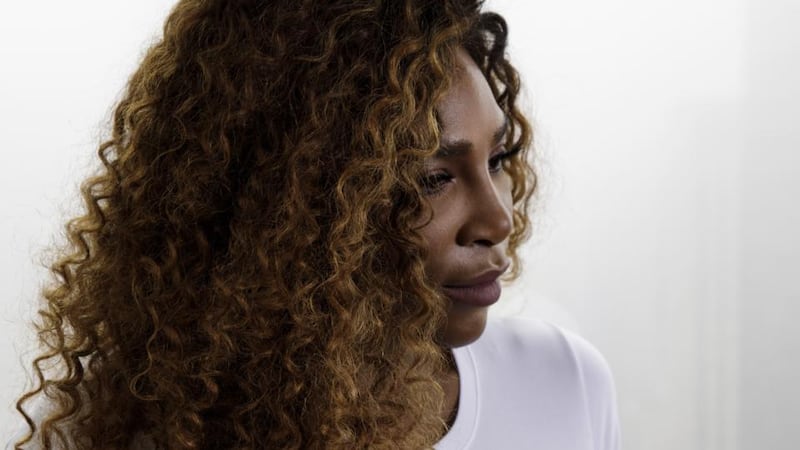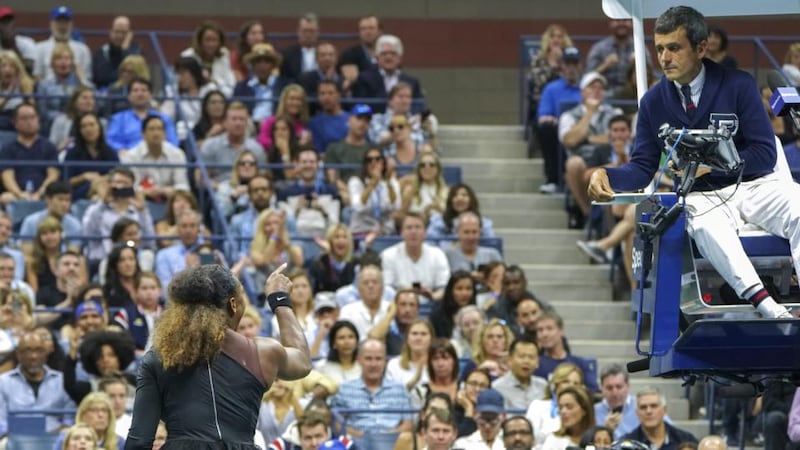Look at this cartoon. What do you see: a clever bit of satire, poking fun at a tennis legend’s petulant behaviour; or an image with dark resonances of another era, when black people were routinely depicted as less than human and when assertive women were regarded as hysterical?
The cartoon, published in the Melbourne-based Herald Sun – which is owned by Rupert Murdoch's News Corp – renders Serena Williams in a full-blown tantrum, jumping up and down on her racket, her face contorted until it looks more animal than human.
The image has provoked an instant storm on social media, and been widely condemned as racist and sexist. Observers have drawn attention to its depiction of Williams’s facial features and pose, and the bizarre portrayal of her opponent in the final of the US Open, Naomi Osaka, who is Haitian-Japanese, as a blond white woman.
The saddest part about Mark Knight’s cartoon depiction of Serena Williams and Naomi Osaka, is that he believes that he has done nothing wrong and that everyone is overreacting and does not understand the art of caricature. Racist bigotry at its finest.
— NUFF (@nuffsaidny) September 10, 2018
Well done on reducing one of the greatest sportswomen alive to racist and sexist tropes and turning a second great sportswoman into a faceless prop. https://t.co/YOxVMuTXEC
— J.K. Rowling (@jk_rowling) September 10, 2018
Criticism of Mark Knight's Serena Williams cartoon shows the world has gone too PC & misunderstands the role of news media cartoons and satire. Poor behaviour in any sport needs to be called out. #media #cartoons #markknight @Knightcartoons @theheraldsun https://t.co/KQFuvIJp0Q pic.twitter.com/sRo3AQ1cJW
— Michael Miller (@mm_newscorpaus) September 10, 2018
1. #SerenaWilliams does not look like this.
— Ryan Knight (@ProudResister) September 10, 2018
(Serena is beautiful)
2. @SerenaWilliams did not act like this.
(Serena stood up for herself)
3. @Naomi_Osaka_ does not look like this.
(Naomi is not blonde or white)
This is the most racist and sexist cartoon that I have ever seen. https://t.co/qlIi59rAL8
This is what Australia does. This is what it has always done to people of color and, in particular, black women who reach the top
In response, News Corp is adopting a position of defiance, rallying the troops on Twitter and in print (where there are no fewer than five anti-Williams opinion pieces today) in support of the cartoonist in question, Mark Knight. "The cartoon about Serena is about her poor behaviour on the day, not about race," Knight himself says in today's Herald Sun.
For him the response seems to indicate that we have succumbed to an outrage culture. "The world has just gone crazy," he says. He has added on ABC that he had "no knowledge" of the racist cartoons of the Jim Crow era – to which, many observers point out, his drawing bears more than a passing likeness – and that people are "making that stuff up". "Maybe there's a different understanding of cartooning in Australia to America," he suggests.
News Corp Australasia's executive chairman, Michael Miller, has tweeted that the world has gone "too PC" and "misunderstands the role of news media cartoons and satire". The newspaper's editor, Damon Johnston, insists: "@Knightcartoons cartoon is not racist or sexist . . . it rightly mocks poor behaviour by a tennis legend . . . Mark has the full support of everyone @theheraldsun."
But observers are not convinced. Bernice King, the chief executive of the King Center and daughter of Martin Luther King, has replied: "So unfortunate that this is your response; and without consideration for the painful historical context of such imagery and how it can support biases and racism today. Why wouldn't a human being care about that?"
For some the controversy underlines how far Australia still has to go to confront its tolerance of racism and misogyny. "This is what Australia does," Shareena Clanton, an Aboriginal Australian actor and activist, has told the New York Times. "This is what it has always done to people of color and, in particular, black women who reach the top."

The Australian writer Yassmin Abdel-Magied, who has spoken of her own experiences of racism and sexism in her country, has tweeted in response to the cartoon: “Racism – as in, the structures of society that make it difficult for those who are non-White to be truly and unconditionally ‘Australian’, and that perpetuate systemic inequality in Australia – is so embedded, is such a normal way of ‘doing business’, pointing to it feels facile.”
But what about the “it’s just satire” argument?
Cartoonists frequently point out that their job is to be provocative, that their craft is built on a rich and sometimes uncomfortable tradition of going where polite commentary will not. But drawing on century-old racist iconography in order to make a point is not provocative or clever. It’s just racist.
Knight and his supporters insist that his cartoon is making a statement about Williams's unsporting behaviour, not her race or sex. Any allusion to racist cartoons of the past is entirely in the eye of the oversensitive, outrage-mongering beholder. "It's getting harder to be a cartoonist in this crazy anxious world – in this fragile angry humourless environment where leniency and understanding are in dangerous decline," another Australian cartoonist, Michael Leunig, says in the Herald Sun.
But even unintentional racism is still racism. “It’s a bit of craic” racism is still racism. “I didn’t mean any offence” racism is still racism. And “She was wrong too” racism is still racism.

The issue is not whether you believe Serena Williams was justified or out of line. It’s not about whether there are cultural differences between Australia and the rest of the world. It’s about whether it is ever acceptable to use someone’s race, gender or ethnicity to lampoon them.
I doubt many Irish observers can have looked at the Serena Williams cartoon without being reminded of our own grim history at the hands of cartoonists of the Victorian era, who depicted us as heavy-browed apes, feckless alcoholics and combative thugs. Those thick-Paddy stereotypes haven't entirely gone away, either: it's only four years since the Irish Ambassador to Australia, Noel White, spoke out against the portrayal of us, in some sections of the Australian media, as akin to the caricature of "the fighting, drinking, dissolute Irish, notoriously promulgated in the pages of Punch in the 19th century".
At what point do such portrayals stop being "satire", or courageous attempts to "mock poor behaviour", and become merely old-fashioned racism? The answer, for many observers, is the point at which a 23 time grand-slam champion, and arguably the greatest sportswoman alive, is reduced to the kind of caricature that wouldn't have looked out of place in Punch or the pamphlets of the Jim Crow era.




















